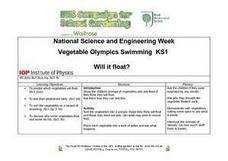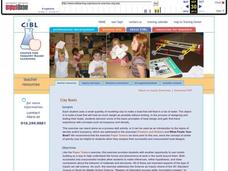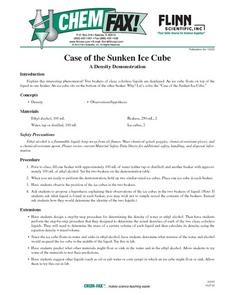Curated OER
Vegetable Olympic Swimming: Will it Float?
Students inspect nutrition by conducting a science experiment in class. In this vegetable identification lesson, students examine a group of different veggies and predict whether they will sink or float in a tub of water. Students check...
Curated OER
Volumw Measurement, English System
Eighth graders biew each volume container and discuss where they have seen them in their home, and how they have seen them used. They explore the different names of volume sizes and their equivalents towards one another. Students...
Curated OER
Clay Boats
Seventh graders are given the opportunity to use model-building as a way to help comprehend the forces and phenomena at work in the world around them. They use both successful and unsuccessful models to make inferences, refine...
Curated OER
Chemistry: The Case of the Sunken Ice Cube
Students examine a density demonstration involving ice cubes and beakers of water and alcohol. After observing how one ice cube floats in water and sinks in alcohol, they determine which mixture of the two would suspend the ice cube in...
Curated OER
Float Your Boat
Students investigate buoyancy, displacement and density. In this flotation lesson plan students study the Archimedes' Principle, analyze data and draw conclusions.
Curated OER
Locating Vent Fields Using CTD Data
Students describe the way hydrothermal vents work. Students work on locating vent regions through remote collection of data about water temperature and density. Comparing density and temperatures graphs, students search for indicators...
Curated OER
Stomata
Students explore what the stoma does for a plant. In this botany lesson students complete a stomatal peel experiment and measure its densities.
Curated OER
Effects of the Southern Pacific Railroad Causeway
Fifth graders describe the appearance of a substance before and after a physical change. They re-create the Southern Pacific Railroad Causeway across the Great Salt Lake. They determine for themselves how the water is exchanged...
Curated OER
Get to know H2O!
Students investigate scientific concepts and inquire about physical states of matter. The transition of water is considered and is easy to facilitate because of its abundance and often observed physical changes.
Curated OER
Investigating Convection Currents
Students examine how differences in the temperature and salinity of the water help create ocean currents. They perform an experiment which shows how temperature affects the circulation of ocean water.
Curated OER
Cody's Science Education Zone
Students observe a scientific experiment and pose a hypothesis. In this scientific inquiry lesson, students make predictions about the combination of alcohol in water and how it will affect a floating ice cube.
Curated OER
HOW FAST DO SEDIMENT GRAINS OF DIFFERENT SIZES SETTLE?
Students conduct an experiment using sand, a jar, and a paper clip to analyze the effects of different kinds of sand vis a vis its sediment. They graph their findings and analyze for factors of size, shape, and density.
Curated OER
Earth Science: The Structure of the Earth
Students identify and complete activities about the structure of the Earth. For this Earth structure lesson, students view a Powerpoint about the Earth's layers and complete a diagram. students compare temperatures in the Earth's layers...
Curated OER
Air: Demonstrating Its Presence and Effects
Students explore the concept of air. In this gravity lesson plan, students perform various experiments that deal with gravity, air resistance, and air pressure.
Curated OER
Project Geode
Students predict the appearance of a geode's internal structure based on its mass and density. They form a hypothesis based on the data they collect. They also identify common minerals found in Illinois.
Curated OER
Sunlight and Warm Air
Students discuss radiant energy from the sun, performing a simple experiment with sun glasses and bright light to demonstrate the concept. Students further participate in simple in-class experiments to demonstrate: air density as it...
Curated OER
The Drag of Drag
Students are told that any object moving through a fluid (air, water, molasses, etc) experience a drag force which oppose the motion. They are given the summarized version of drag which is proportional to the square of the velocity....
Curated OER
Paper Chromatography
Students use this design the illustrate how ink can be separated into its component chemicals using paper chromatography. They use five unknown samples of ink on pre-labeled chromatography strips are provided to students. Students use...
Curated OER
Organisms and Their Environment
Students explore Earth's biosphere. In this biosphere instructional activity, students participate in group activities regarding biotic and abiotic factors, population density, and species' habitats.
Curated OER
Shake, Rattle and Roll
Students compare the weathering of materials. in this weathering lesson, students experiment with the chemical and physical weathering of different materials. Students use salt and water as an example of how weathering occurs.
Curated OER
Science Lesson #2
Fourth graders explore and experiment with objects that float to see if they float differently in salt water or fresh water. After the experiment, they write a paragraph in their science journal explaining how fresh water and ocean water...
Curated OER
Hurricanes
Students state and directly experience two laws of Physics (Law of Gravity, Law of Centrifugal Force) that affect weather. They explain the observations made when using the "hurricane machine" and relate them to other events and phenomenon.
Curated OER
Icebergs Ahead!
Students experiment with density of ice, and examine how density affects how icebergs float in water.
Curated OER
WHY DO SOME THINGS FLOAT WHILE OTHERS SINK
Young scholars explore how density can cause things to sink or float by experimenting with a jar, oil and corn syrup.























